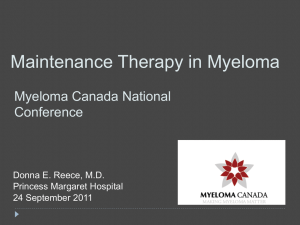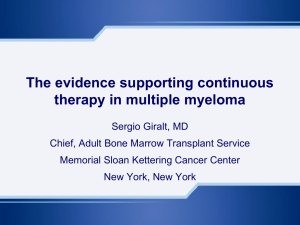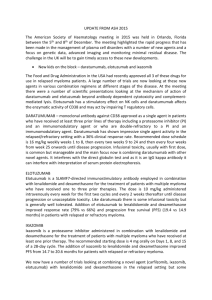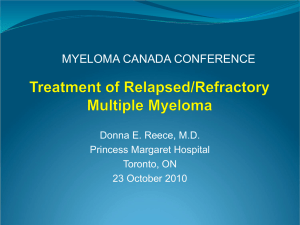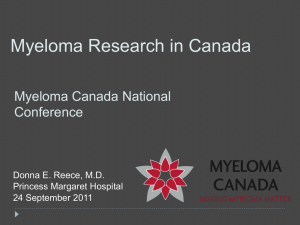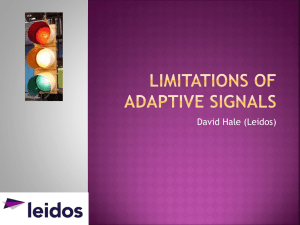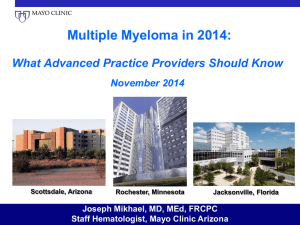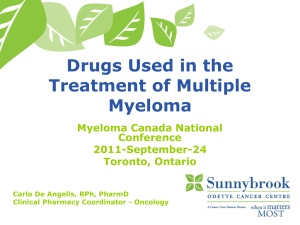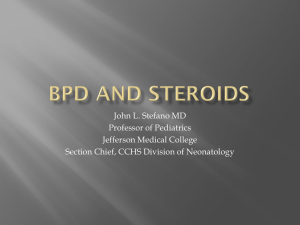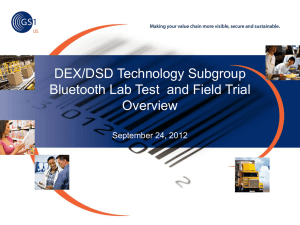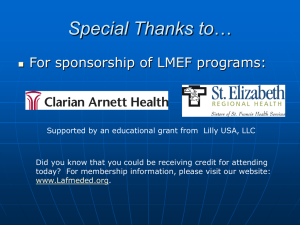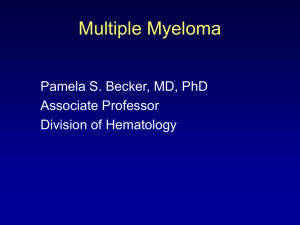Median PFS - Myeloma Canada
advertisement
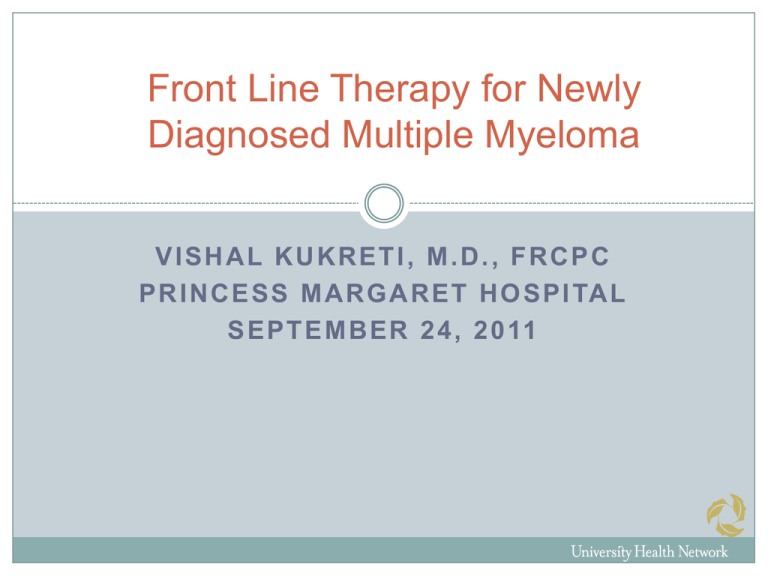
Front Line Therapy for Newly Diagnosed Multiple Myeloma VISHAL KUKRETI, M.D., FRCPC P R I N C E S S M A R G A R E T H O S P I TA L S E P T E M B E R 2 4 , 2 0 11 Objectives Overview of Myeloma Treatment options First Line Therapy Transplant Eligible Non-Transplant Eligible Multiple Myeloma Incurable cancer of plasma cells Medullary and extra-medullary disease Antibodies/Immunoglobulins Plasma cells make antibodies (immunoglobulins, Igs) which consist of 2 heavy chains and 2 light chains One type of antibody is made to bind with one foreign substance (virus, bacteria, etc.) Patterns of Antibody Production Serum Protein Electropheresis Normal SPEP Multiple Myeloma Types of Multiple Myeloma Diagnostic Criteria Diagnosis based on finding over 10% plasma cells (antibody forming cells) in bone marrow Symptomatic myeloma characterized by “CRAB” Anemia (<100 or 20g/L below normal) Bone lesions - lytic Kidney damage (Creatinine 176 umol/L) Elevated blood calcium (>2.8mmol/L) Findings at diagnosis - MM Anemia – 80% Renal dysfunction – 20% Hypercalcemia – 25% Bone destruction – 75% Hyperviscosity - <5% M-protein Identification Serum – 80% Urine – 20% Neither (non-secretory) – 1-2% Age-specific incidence of MM Ineligible Transplant candidates 70 Male cases Female cases Male rates Female rates 50 40 200 30 20 100 10 Age at diagnosis http://info.cancerresearchuk.org/cancerstats/types/multiplemyeloma 85+ 80-84 75-79 70-74 65-69 60-64 55-59 50-54 45-49 40-44 35-39 30-34 25-29 20-24 15-19 10-14 0 5-9 0 0-4 Number of cases 300 60 Rate per 100,000 population 400 Staging of Myeloma International Staging System Risk Category 1 2 3 Characteristics 2 M 3.5 mg/L + albumin 35 g/L 2 M 3.5 mg/L+ albumin 35 g/L or 2 M 3.5 – 5.5 mg/L 2 M 5.5 mg/L Survival and ISS score FISH Cytogenetics in Myeloma t(4;14)=15% (dysregulation of FGFR3 and MMSET) p53 deletion=10% (loss of tumor suppressor gene) Combining Beta 2-Microglobulin and FISH Identifies 3 Prognostic Groups No t(4;14), no del17p, b2m£4 mg/L, no del13 35% 50% No t(4;14), no del17p, b2m£4 mg/L, del13 No t(4;14), no del17p, b2m>4 mg/L, no del13 No t(4;14), no del17p, b2m>4 mg/L, del13 p=2.10-13 15% t(4;14) or del17p, b2m£4 mg/L t(4;14) or del17p, b2m>4 mg/L Avet-Loiseau H. Blood. 2007;109:3489-3495. Treatment – Principles Bisphosphonates ◦ Osteonecrosis of the jaw – 1.8 to 12.8% ◦ Duration of therapy Vertebroplasty/Kyphoplasty Infections Induction Therapy – Transplant Eligible vs Ineligible Autologous Stem Cell Transplant Maintenance therapy post-stem cell transplantation Autologous Stem Cell Transplant Patient Priming Therapy Collect PBSCs High-dose Chemotherapy Reinfuse PBSCs +/- Post-ASCT therapy Freeze Where We’ve Been with Initial Therapy ASCT Preceded by VAD, Dex Melphalan + Prednisone Overall response rate 40-50% alone or Thal/Dex x 4 cycles CR/nCR 5% Melphalan 200 mg/m2 Median PFS 12-15 mos Overall response rate 80% Median OS 30-36 mos CR/nCR rate 20% Median PFS 20-36 mos Median OS 48-60 mos Novel Agents in Multiple Myeloma Thalidomide Bortezomib Lenalidomide Agent Class Effects Toxicity Thalidomide (Thalomid®) IMiD Immunomodulatory effects - inhibits TNFa, inhibits angiogenesis, stimulates Tcells (CD8), alters cytokine production, impedes binding to stromal cells Teratogenicity, PN, sedation, rash, constipation, DVT Bortezomib (VelcadeTM) Proteasome inhibitor Decreased adhesion, cytokine production, angiogenesis, NFkB, DNA repair Fatigue, PN, GI toxicity Decrease in neutrophils, platelets and lymphocytes Lenalidomide (CC-5013; Revlimid®) IMiD Stimulate T-cell proliferation, upregulate IL-2 and IFN-g, inhibit TNFa and IL-6Decreased adhesion, alter synthesis of cytokines, induce growth arrest and caspase dependent apoptosis NK cell cytotoxicity Myelosuppression, DVT Strategies to Improve ASCT Results Improved induction therapy Risk Stratification – t(4;14) Improved dose intensive therapy Tandem ASCT New regimens (“Vel-Mel,” Bu-Mel, busulfex + bortezomib) Post-ASCT therapy Consolidation Maintenance Induction Trials before ASCT Many phase I-II trials of 3- and 4-drug regimens May allow option to continue regimen without ASCT Phase III trials that include ASCT 3 compare novel regimen with VAD 2 compare novel regimen with thalidomide + dex 1 compares novel regimen with bortezomib + dex Novel Induction Regimens before ASCT VAD or Dex THALIDOMIDE ThalDex* TAD* CTD* *Studied in phase III transplant trials BORTEZOMIB (VELCADE) Bortez+Dex* VTD* PAD* VCD Cybor-D RVDD Stem cell harvest High-dose melphalan + ASCT LENALIDOMIDE (REVLIMID) RD Rd RVD RD: Lenalidomide + high-dose dex Rd: Lenalidomide + low-dose dex Study/Author N Induction regimen MAG/Macro 204 Thal + dex VAD 1 - - HOVON-50/ Lokhorst 536 TAD VAD 1 - Thal Interferon IFM 2005-02/ Harousseau 482 BD VAD 1 or 2 +/- len +/- len HOVON 65/ GMMG-HD4/ Sonneveld 613 VAD PAD 1 or 2 - Thal 50 mg/d B 1.3 mg/m GIMEMA MMY3006/ Cavo PETHEMA/ GEM05MEN0S65/ Rosinol 447 VTD Thal + dex 2 VTD Thal + dex Dex Dex 306 Thal + dex VTD VBMCP/VBAD/ Vel Vel/dex vTD 1 - - 1 or 2 - - IFM 200702/Moreau # Consolidation Maintenance ASCT (q 2 weeks) 199 Study/Author Induction regimen # ASCT + Post-Rx Post-ASCT Response (%) VGPRc(CR+n CR) Median PFS (mos) Median Overall Survival (mos) MAG/Macro TD 1 44 - HOVON-50/ Lokhorst TAD 1+Thal 66 (31) 34 73 BD 1 or 2 +/- Len 54 (35) 36 81% 1 or 2 + bortez 75 (50) 2 + VTD + Dex 87 (55*) IFM 2005-02/ Harousseau HOVON 65/GMMG-HD4/ Sonneveld GIMEMA MMY3006/Cavo PAD PETHEMA/ Rosinol VTD 1 IFM 200702/Moreau Vel/dex vTD 1 or 2 VTD (3 yrs) 42% 78% (3 yrs) (3 yrs) 85% 96% (2 yrs) (2 yrs) (46*) NYR 73 (61) - 76% (4 yrs) - “CYBOR-D”: Phase II Trial Newly Diagnosed Myeloma 28 day cycle Schedule Bortezomib Cyclophosphamide Dex Dose (mg/m2 ) Day Days (300 mg/m2) Days (40 mg) Biweekly 1.3 1,4,8,11 1,8,15,22 1-4, 9-12, 17-20 Weekly 1.5 1,8,15,22 1,8,15,22 Same x 2 cycles, then decreased to 1,8,15,22 •Rapid onset •Responses after 4 cycles of weekly dosing: •ORR 98% •≥VGPR 68% •CR/nCR 43% •No issues with SC collection Reeder C, et al. Leukemia 2009; 23: 1337-1341; Reeder CB, et al. Blood 2010; 115: 3416-3417. Induction Therapy before ASCT - Summary Advantages of bortezomib-containing induction Rapid induction of remission Effective in renal failure Effective in high-risk cytogenetic subgroups Some evidence that 3- and 4-drug regimens produce higher remissions, and convey better PFS Combinations of bortezomib and IMiDs very costly Weekly bortezomib carries much lower risk of PN PMH approach is to use CYBOR-D x 4 cycles Randomized Tandem ASCT Trials N PostASCT Rx Attal, 2003 399 α IFN 42 50 25 30* 48 58* Fermand, 2003 277 None 39 37 31 33 49 73 Goldschmidt, 268 2005 α IFN -- -- 22 NYR* 23 NYR Sonneveld, 2004 303 α IFN 13 28 20 22* 55 50 Cavo, 2007 321 α IFN 38 48 23 35* 65 71 * p< 0.05 CR/VGPR rate (%) Single Tandem Median PFS (months) Single Tandem Median OS (months) Single Tandem Newer Post-ASCT Strategies Consolidation VTD (GIMEMA trial) Lenalidomide + dexamethasone (IFM 2005 02) Bortezomib (Nordic Myeloma Study Group trial) RVD (CTN trial) Maintenance Lenalidomide (CALGB trial, IFM 2005 02) IFM/Dana Farber 2009 Trial VRD x 3 SC collection CY + G-CSF VRD x 5 Melphalan 200 mg/m2 + ASCT VRD x 2 Rev maintenance x 1 yr Rev maintenance x 1 yr HDM + ASCT recommended at relapse ASCT will be considered pertinent if EFS is prolonged by ≥ 9 months ASCT in Myeloma Summary and Conclusions Several approaches integrating novel agents with ASCT improve outcome Difficult to dissect contribution of induction, consolidation, maintenance Improved response rates with newer strategies ≥ VGPR rates 60-75%; CR/nCR rates 30-50% Median PFS has improved from 2 to 3 years 3 ½ years with lenalidomide maintenance Overall survival results are improved in some studies Where We Are Now ASCT Preceded by novel induction regimens Melphalan 200 mg/m2 +/- second ASCT +/thalidomide maintenance Overall response rate 80-90% CR/nCR rate 35-50% Median PFS 36 mos 2 year OS 90-93% MPT or MPV or Lenalidomide + Dex Overall response rate 65-75% CR/nCR 20-25% Median PFS 24-30 mos Median OS 48-50 mos 2 year OS 70-93% Transplant-Ineligible Patients – Balancing the Toxicities and Efficacy of Novel Agents How do we choose initial therapy in non-transplant patients? Drug availability Practical considerations Patient-related features Co-morbidities (diabetes, peripheral neuropathy) Marrow reserve Renal function Disease-related features Aggressive biology, such as t(4;14) Light chain nephropathy Treatment related features Rapidity of response Toxicity profile (VTE, peripheral neuropathy) New Treatment Options for Newly Diagnosed Myeloma Patients Non-transplant Candidates Add novel agent to melphalan + prednisone Continuous suppressive therapy with IMiD + dexamethasone (lenalidomide + weekly dex) Combination therapy with 3-4 drug regimens +/maintenance 1Morgan CTD1 RVD2 CyborD3 • VDC4 • VDCR4 • Thal + dex + PLD5 • VMPT6 G, et al. Blood 2007;110: abstract 3593 2Richardson PG, et al. Blood 2008;112: abstract 92; 3Reeder CB, et al. Leukemia 2009;23: 1337-1341; Kumar S et al. Blood 2009; 114: abstract 127; 5Offandini M, et al. Br J Haematol 2009;144: 653-659.; 6Palumbo A, et al. Blood 2009; 114: abstract 128. Best Reported Outcomes with Newer Non-ASCT Regimens in Phase III Trials Author Rx Duration of therapy (wks) Overall response rate (CR+nCR) (%) Median PFS (mos) Median OS (mos) 2 year OS (%) Facon1 MPT 72 76 (18) 27.5* 51.6* 78 MPT+ T 24+ 76 (28) 21.8* 45 82 Hulin3 MPT 72 61 (7) 24* 45* 70 San Miguel4 VMP 54 71 (35) 24* NYR* 83 Palumbo5 MPR+ R 40+ 77 (18) NYR* NYR ~70 Rajkumar6 Len+dex Until prog 70 (14 CR) 25.3 NYR 87 Palumbo2 *Significant benefit over MP alone 1Facon T, et al. Lancet 2007:370; 1209-1218; 2Palumbo A , et al. Blood 2008;112: 3107-3114; 3 Hulin C, et al. Blood 2007; 110: abstract 75;4San Miguel JF, et al. N Engl J Med 2008; 359: 906-917; 5 Palumbo A, et al. Blood 2009; 114: abstract 613; 6Rajkumar SV, et al. Lancet Oncol 2010; 11: 29-37. IFM 99/06: MPT vs MP vs Mel100 65-75yo PF S M P OS MP T M P MP T M Melphalan 0.25mg/kg and Prednisone 2mg/kg, days 1-4, for 12 cycles, q 6 weeks P MP MP plus thal 200-400 mg/d (with no maintenance thalidomide phase) T MEL100 VADx2 + MEL100x2 + ASCTx2 Facon et al, IFM 99/06, Lancet 2007 MPT vs MP studies Study ORR (%) CR (%) PFS Median (mos) OS Median (mos) OS p-value IFM 99/06 76 v 35 13 v 2 28 v 18 52 v 33 0.0006 61 v 31 7v1 24 v 19 44 v 29 0.03 62 v 47 2v2 15 v 11 40 v 31 0.05 76 v 48 16 v 4 22 v 15 45 v 48 NS 57 v 38 13 v 4 15 v 14 29 v 33 NS Facon1 IFM 01/01 Hulin3 HOVON Wijermans5 GIMEMA Palumbo2 Nordic Waage 1Facon 4 T, et al. Lancet 2007;370:1209-18; 2Palumbo A, et al. 2008; 112: 3107-3114; 3Hulin C, et al. J Clin Oncol 2009 May 18 [Epub¸ahead of print]; 4Waage A, et al. Blood 2007;110:abstract # 76; 5Wijermans P, et al. Blood 2008; 112: abstract #649; 6San Miguel J, et al. 2008; New Engl J Med 2008; 359: 906-917. Select toxicities: MPT vs MP (Grade3-4) Facon et al., IFM 99–06: 65-75yo MP (N=193) MPT (N=124) P-value Neutropenia 26% 48% <0.0001 Thrombosis/embolism 4% 12% 0.0008 Peripheral neuropathy 0 6% 0.001 Solmolence/fatigue/dizziness 0 8% <0.0001 0.5% 2% Rate too low 0 10% <0.0001 Cardiac (arthymia, CHF) constipation VISTA: VELCADE as Initial Standard Therapy in multiple myeloma: Assessment with melphalan and prednisone VMP Cycles 1-4 Bortezomib 1.3 mg/m2 IV: days 1,4,8,11,22,25,29,32 Melphalan 9 mg/m2 and prednisone 60 mg/m2 days 1-4 Patients with newly diagnosed MM not transplant eligible due to age (≥65 years) or coexisting conditions R A N D O M I S E Cycles 5-9 Primary Endpoint: Bortezomib 1.3 mg/m2 IV: days 1,8,22,29 TTP Melphalan 9 mg/m2 and prednisone 60 mg/m2 days 1-4 9 x 6-week cycles (54 weeks) in both arms MP Cycles 1-9 Melphalan 9 mg/m2 and prednisone 60 mg/m2 days 1-4 Conducted at 151 centres in 22 countries in Europe, North and South America, and Asia. San Miguel et al. N Engl J Med 2008; 359: 906-917 Secondary Endpoints: CR rate ORR TTR DOR PFS TNT OS QoL VISTA: Select patient demographics and disease characteristics Median age ≥75yo KPS ≤70%, (~ECOG 2+) % ISS Stage I / II / III, % Lytic bone lesions, % Serum creatinine, median (mg/dL) CrCl ≤30 / >30-60 / >60 ml/min, % History of neurological conditions, % History of cardiac conditions, % VMP MP 71 31 35 71 30 33 19 / 47 / 35 65 1.1 6 / 48 / 46 18 35 19 / 47 / 34 66 1.1 5 / 50 / 46 20 31 San Miguel et al. N Engl J Med 2008; 359: 906-917 VISTA: VMP vs MP (9 cycles) TTP OS San Miguel et al. (VISTA). N Engl J Med 2008;359:906-17. VMP: Consistent efficacy in patients with poor prognostic characteristics High-risk vs. standard-risk cytogenetics TTP 1 OS 2 high standard standard high Time (months) Time (months) Median follow up: 25.9 months Median follow up: 36.7 months 1. San Miguel et al. N Engl J Med 2008; 359: 906-917 (Suppl) 2. Mateos et al. J Clin Oncol 2010; 28: 2259-2266 Select Grade 3-4 Adverse events: VISTA Updated data VMP (N=340) MP (N=337) Neutropenia 40 38 Thrombocytopenia 38 31 Anemia 19 28 Leukopenia 24 20 Lymphopenia 20 11 Pneumonia 7 5 Peripheral sensory neuropathy 14 0 Fatigue 8 2 Diarrhoea 8 1 Minimizing Neuropathy: once- vs. twice-weekly bortezomib – GIMEMA study VMP (Twice weekly) VMP (Once weekly) CR 27% 23% PFS @ 3years 32% 35% OS @ 3 years 86% 85% Any grade 43% 21% Grade 3-4 14% 2% PN discontinuation 16% 4% Total planned dose 67.6 mg/m2 46.8 mg/m2 Total delivered dose 41 mg/m2 40 mg/m2 Sensory peripheral neuropathy Once weekly bortezomib is new standard schedule! Palumbo et al; ASH 2010, Abstract #620 E4A03: Phase III trial of LD vs Ld in newly diagnosed MM If PD within 4 mo Newly Lenalidomide + HighDose Dexamethasone (LD) [40 mg, d 1-4, 9-12, 17-20] Salvage therapy Thalidomide 200 mg/d po, days 1-28 High-dose (Arm III) vs Lowdose (Arm IV) Diagnosed Myeloma N = 445 Lenalidomide + LowDose Dexamethasone (Ld) [40 mg, d 1, 8, 15, 22] DSMB mandated crossover to Low-dose dex (Ld) March 27, 2007 N = 79 patients on study at time of crossover Lenalidomide: 25 mg daily, days 1-21 of 28-day cycle; D: High-dose Dex: total 480 mg/28-day cycle; d: Low-dose Dex: total 160 mg/28-day cycle Vesole DH et al. ASH 2010; Abstract 308. LD vs Ld: Overall Survival by age Age > 65 Age > 75 Len plus low-dose dex is safe and effective for both older and younger patients Vesole et al; ASH 2010, Abstract 308 LD versus Ld: Toxicities LD n=223 Ld n=220 P-value Response at 4 cycles 79% 68% 0.008 VGPR 42% 24% <0.008 Blood clots 26% 12% <0.001 Infection 16% 9% 0.043 Severe toxicity 53% 31% <.001 Early deaths 5% 0.5% 0.003 RD in comparison to Rd is slightly more effective but significantly more toxic. Once weekly DEX is now widely used and is generalized to the relapsed setting and to use with other novel agents Rajkumar et al Lancet Oncol 2010;11:29-37 Conclusions Not all elderly are the same. Not all myeloma is the same Bortezomib-based induction (e.g. VMP) is reasonably well tolerated and associated with enhanced OS in most patients >65yo and >75yo (and is funded in Ontario) Oral induction regimens (e.g. MPT, MP or len/dex) may be appropriate in some non high-risk patients In patients with renal impairment or t(4;14), -17p a velcade-based induction regimen is preferred (e.g. VMP) Higher intensity regimens less beneficial and may be adverse in frail patients Weekly bortezomib is a new standard of administration Low dose dex is the standard of care in lenalidomide Niesvizky et al. Haematologica 2011; 96 (s1): S98 (Abstract P-228); poster presentation at IMW 2011 PMH Approach to Front Line Therapy Transplant Eligible (<65) Non-Transplant Eligible (>70) Ages 65-70 Cybor D Induction (clinical trials) ASCT (Tandem if high risk) Maintenance Lenalidomide VMP MPT MP (Clinical trials)
